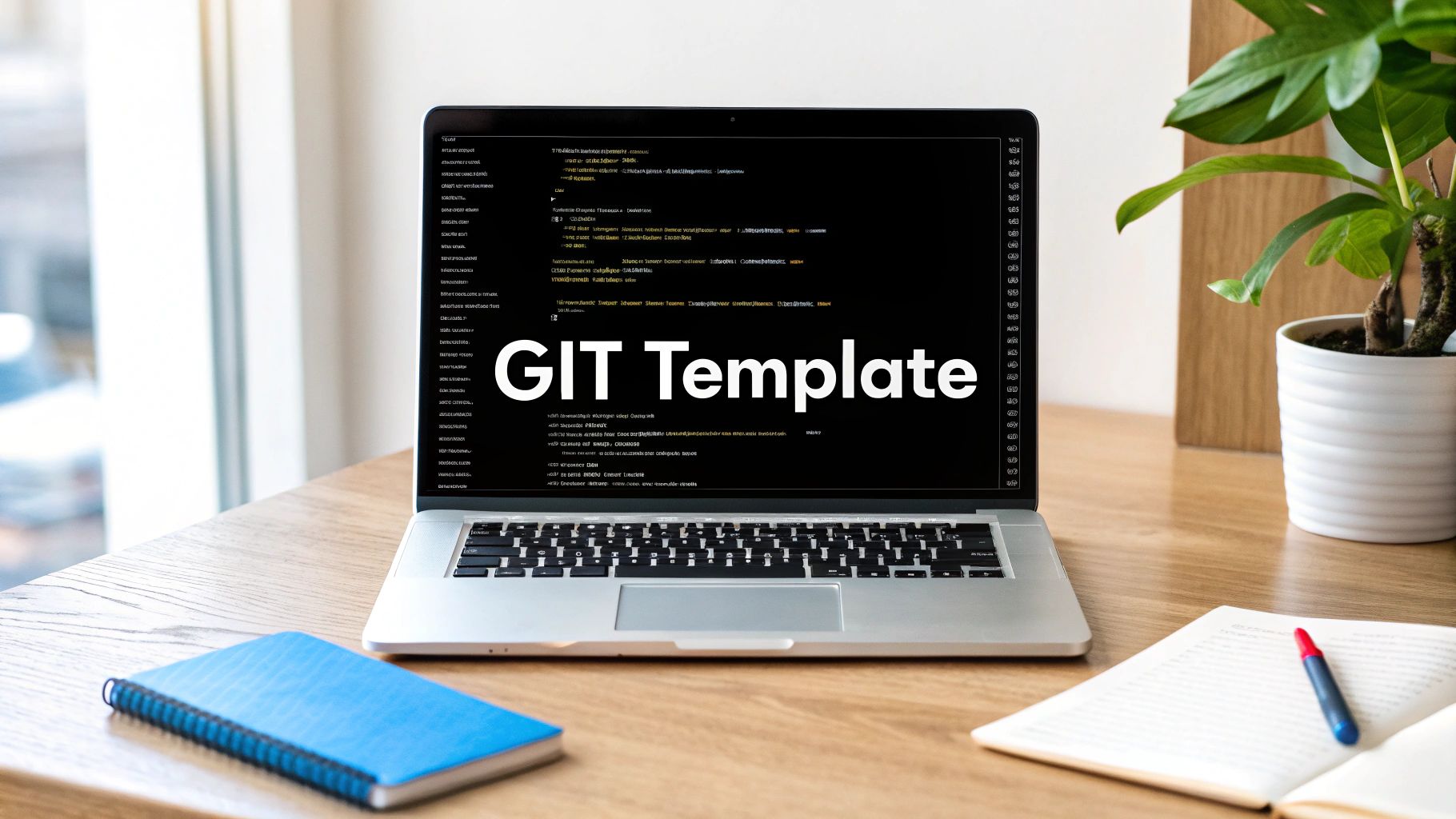Boost Your Workflow with git commit template
Why Git Commit Templates Are Your Secret Weapon
Inconsistent commit messages create confusion and slow down development. They make understanding project history, tracking bugs, and collaborating effectively much harder. Think of your project's commit history as a library. Without a clear cataloging system (your commit messages), finding the right book (the specific change you need) is a nightmare. This is where git commit templates come in. They provide a structured framework, turning chaotic histories into searchable documentation.
Benefits of Using Git Commit Templates
Git commit templates are more than just formatting preferences. They're a powerful tool for streamlining your development workflow. Enforcing consistency improves readability. It also makes it easier for everyone on the team to understand codebase changes.
This clarity leads to more efficient code reviews. Reviewers can quickly grasp the context and intent of each commit. Well-structured templates also help onboard new team members. They offer a clear, consistent method for navigating the project's history.
For example, a template might require:
- A brief summary of changes
- A detailed description of the implementation
- Any relevant issue numbers
You might be interested in: How to master Git commit message conventions.
These benefits are tangible. As of 2025, using a git commit template has become increasingly important for collaborative teams. Using a well-structured template, often following the Conventional Commits format, improves readability. Prefixes like feat, fix, and docs can increase readability by up to 80% compared to unstructured formats. They also reduce confusion during code reviews by about 40%. Learn more about commit messages best practices here. This structure provides a standard way to document changes, making it easier to understand the code's evolution.
Real-World Impact of Git Commit Templates
Imagine a critical bug fix deployed late at night. Weeks later, the team needs to understand the implemented changes. With inconsistent commit messages, this becomes time-consuming and frustrating. A well-defined git commit template lets the team quickly locate the relevant commit and understand the fix, saving time and reducing headaches.
Git commit templates also improve release management. Adhering to a standardized format, especially one aligned with semantic versioning, makes automating changelog generation significantly easier. This automation saves developers time and ensures accurate, comprehensive release notes. This creates a more polished and professional release process.
Git commit templates are a secret weapon for a more efficient and collaborative development process. They empower teams to communicate effectively, maintain a clean codebase, and unlock the potential for powerful automation.

Creating Your First Git Commit Template That Actually Works
Stop staring at a blank commit message screen! This guide walks you through creating effective git commit templates that developers will actually use. We'll cover setting up templates locally for personal projects and globally for consistent messaging across all your work. This simplifies creating commit messages and promotes clear project histories.
Setting Up Your Template
Creating a git commit template is simple. Start by creating a plain text file. Name it something descriptive like commit-template.txt. Inside this file, define the structure for your commit messages. For a better understanding of how commit templates fit into the larger picture, check out these Git Workflow Best Practices.
For example, a basic template might look like this:
Summary: <One-line summary of the change>
Description: <More detailed explanation of the change>
Issue: <Reference any related issue numbers>
These placeholders guide developers when they write commit messages. This structured approach ensures consistent and informative commits.
Configuring Git To Use Your Template
After creating your template, tell Git where to find it. For a local setup, navigate to your project's root directory in the terminal. Use the command: git config commit.template <path/to/your/commit-template.txt>. This configures Git to use your template for that specific project.
Alternatively, configure a global template to use the same format across all your projects. Execute the following command: git config --global commit.template <path/to/your/commit-template.txt>. The adoption of git commit templates has increased significantly since the introduction of the Conventional Commits specification in 2016. By September 2022, over 60% of GitHub projects using Conventional Commits reported improved code quality and review efficiency. This improvement is partly due to how easy it is to create and integrate templates. The global setup, for example, is a simple command used by about 75% of developers who prefer a consistent commit message format. Explore this topic further.
Verifying Your Template
After setting up your template, test it. Start a commit using git commit. Your pre-filled template should appear in your default text editor. Fill in the placeholders with your commit details and save. This confirms your configuration is successful.
Troubleshooting Common Issues
If your template isn't appearing, double-check the file path in your Git configuration. Ensure the file exists and is accessible. Also, verify you're using the correct Git command for local or global setup. These steps usually resolve most template-related issues.

Choosing The Right Configuration Method
The following table summarizes the different ways to configure git commit templates, outlining their advantages and use cases. This information will help you select the most suitable method for your workflow.
| Configuration Method | Command Syntax | Scope | Best For |
|---|---|---|---|
| Local | git config commit.template <path/to/template> | Specific Repository | Individual projects with unique requirements |
| Global | git config --global commit.template <path/to/template> | All Repositories | Maintaining consistency across all personal projects |
Understanding these configuration methods helps you choose the best approach for your workflow and ensures your git commit template works effectively.
Crafting Templates That Developers Actually Want to Use
Why are some git commit templates overlooked while others become essential tools? The answer lies in understanding both the psychology and the practical needs of developers. Drawing on insights from development leads at successful companies, let's explore the factors that influence template adoption.
Balancing Brevity and Informativeness
A common mistake is creating overly complex templates. While detailed information is important, an excessively long template can feel burdensome. This can lead developers to either submit incomplete information or skip the template entirely. The key is finding a balance between brevity and informativeness. A good git commit template should guide, not overwhelm.
For instance, requiring a lengthy description for every small change will likely be ignored. A concise template requesting a summary, a short description, and relevant issue numbers offers a better balance. This approach promotes consistent documentation without creating unnecessary friction.
Including the Right Prompts
The prompts within your git commit template are essential. They should guide developers toward providing relevant information without being too rigid. Think carefully about which sections genuinely enhance collaboration, such as summaries, descriptions, and issue references. Consider also which sections add unnecessary overhead.
A well-designed template prompts for information that proves useful during code review, debugging, and project history analysis. This means focusing on the context and impact of the change, rather than solely on technical details. A good question to ask is: "Will this information be helpful six months from now?"
Handling Special Cases
Not every commit is the same. Your git commit template should account for special cases like breaking changes and co-authored commits. For breaking changes, a dedicated prompt outlining the impact and migration steps is critical. Likewise, a clear method for attributing co-authors ensures proper credit and simplifies collaboration. Addressing these nuances upfront prevents inconsistencies and improves the overall quality of your commit history. This leads to more efficient workflows and a more thorough project record.
Adapting Templates as Projects Mature
Just as projects evolve, so should your git commit templates. A minimalist template might be sufficient for a small team working on a new project. As the project grows and becomes more complex, the template may need adjustments. Introducing new sections or modifying existing prompts should be a deliberate process, involving feedback from the development team to prevent "template fatigue." This iterative approach ensures the template remains a valuable tool throughout a project's lifespan. Adapting to changing needs is crucial for long-term effectiveness.

To better understand the various template formats available, let's look at a comparison. The following table outlines the strengths, limitations, and ideal use cases for several common approaches.
Popular Commit Template Formats Compared Analysis of common git commit template formats showing their structure, benefits, and limitations
| Template Format | Structure | Strengths | Limitations | Ideal Use Case | |---|---|---|---|---| | Minimalist | Summary, Description | Simple, easy to adopt | May lack detail for complex changes | Small teams, early-stage projects | | Conventional Commits | Type, Scope, Subject, Body, Footer | Standardized, automation-friendly | Can be verbose for simple changes | Teams seeking automation and structured workflows | | Full Featured | Summary, Description, Issue, Breaking Changes, Co-authors | Comprehensive, captures various aspects | Can feel overwhelming if overused | Large projects with diverse contribution needs |
By carefully designing and adapting your git commit templates, you can create tools that developers truly value and use. This results in better collaboration, a clearer project history, and a more efficient workflow.
Getting Your Team Onboard With Git Commit Templates
Creating a well-crafted git commit template is a big step towards better development workflows. But getting your team to use it consistently requires a smart strategy. Simply having a template isn’t enough; you need to encourage real adoption. This means addressing any pushback and showing the template’s value.
Gradual Implementation and Training
Introducing new tools can sometimes be tough. Instead of forcing immediate adoption, consider a phased rollout. Start with a pilot group of team members willing to try the new git commit template. Their feedback will be invaluable for refining the template and finding potential problems before a wider release.
Effective training is also key. Instead of long lectures, go for short, hands-on sessions that show how the template simplifies daily tasks.
Providing clear documentation and readily available examples can also empower team members to use the template correctly. This supportive approach builds a sense of ownership and encourages active participation. By involving the team, you'll create advocates for the new workflow.
Complementary Tools and Addressing Objections
Several tools can reinforce the use of git commit templates subtly. Commit hooks with Git can automatically check if a commit message follows the template before it’s accepted. Similarly, linters can be added to the development environment to give real-time feedback on commit message style and content. These automated checks help maintain consistency without adding extra steps.
Addressing common objections proactively is also key. Some developers might worry that using templates will slow them down. Counter this by showing how a well-designed template actually saves time by providing structure.
Others might question the need for change, especially if current practices seem fine. Emphasize the long-term benefits of consistent commits, like better collaboration, easier debugging, and more efficient code reviews. Using git commit templates has big implications for team productivity and project management. By ensuring every commit adds valuable information, teams can improve project visibility. A well-crafted commit can even reduce debugging time by around 25%. Find more detailed statistics here.
Change Management for Long-Term Success
Implementing a git commit template effectively requires a thoughtful approach to change management. Start by clearly communicating the reasons for the change and the expected benefits. This transparency helps the team accept the new process.
Provide opportunities for feedback and address any concerns openly. This fosters shared ownership and encourages active participation in the transition. Remember, changing habits takes time. Consistent reinforcement and positive feedback are crucial for long-term success.
Leveraging Pull Checklist for Enhanced Workflow
Integrating Pull Checklist, a helpful GitHub Marketplace app, can further boost the benefits of your git commit templates. Pull Checklist automates and streamlines code reviews with customizable checklists.
By embedding required tasks and checks directly into pull requests, you reinforce best practices and ensure every code change meets your standards. This synergy between Pull Checklist and structured commit messages creates a comprehensive and efficient development workflow. The combined power of these tools improves code quality, collaboration, and simplifies code reviews.

Advanced Git Commit Template Techniques That Save Time
Beyond basic git commit templates, a world of advanced techniques can transform commit messages from simple documentation into powerful development tools. These methods streamline workflows and significantly increase the value of project histories.
Dynamic Templates
Leading development teams often utilize dynamic templates that adapt to the situation. Imagine a template that automatically adds the correct Jira ticket number based on the branch name. This saves developers time and reduces cognitive load, particularly during complex projects.
For example, a branch named "feature/JIRA-123-new-login" could automatically populate the "Issue:" field with "JIRA-123". This automated linking clearly connects code changes with their corresponding tickets, improving traceability and simplifying debugging. Learn more in our article about How to master efficient development with Git Workflow Best Practices.
Integrating With Issue Tracking Systems
This dynamic connection is particularly helpful when integrated with issue tracking systems. By linking your git commit template to your issue tracker, you can automate workflows that directly connect code changes to specific tasks or bugs. This minimizes the manual effort needed to cross-reference information.
For instance, when a commit is pushed, a script could update the associated Jira ticket with the commit hash and a brief summary of the changes. This two-way linking provides valuable context for understanding the development history of a feature or bug fix.
Enhancing With Custom Scripts
Custom scripts can further improve the commit process. These scripts can enforce more complex rules than a standard template allows. For example, a script can verify that the commit message follows established conventions, automatically run tests before accepting the commit, or even generate documentation based on the changes.
However, careful implementation is essential. Overly complex or slow scripts can hinder the workflow, negating the time-saving advantages of a template.
Multi-Section Templates for Complex Projects
For larger projects, consider using multi-section templates. These templates enable more detailed commit messages without overwhelming contributors. They can include sections for technical details, user-facing changes, and testing notes.
Think of it like a well-structured report, enabling developers to provide complete information in an organized format. This approach is particularly beneficial for open-source projects or teams with detailed code review processes.
Template Evolution Strategies
As projects grow, your template requirements may evolve. Implementing template evolution strategies helps maintain the effectiveness of your approach. These strategies might involve regular reviews and updates of the template, gathering feedback from the development team, and trying new features or sections.
Keeping your templates current and aligned with the team's needs prevents template fatigue and ensures continued value for the development workflow. This is akin to how coding standards are regularly reviewed and updated—the objective is to uphold best practices. Like code refactoring, a well-maintained template adapts and changes with the project.
Turning Git Commit Templates Into Automation Superpowers
Your well-structured git commit templates unlock powerful automation possibilities, transforming your development pipeline. Standardized commit messages drive automatic changelog generation, making release notes understandable for both developers and stakeholders. This eliminates manual changelog compilation, freeing developers for more critical tasks.
Automating Changelog Generation
Imagine effortlessly generating a changelog with every release. With a consistent git commit template, this becomes a reality. Tools like Conventional Commits can parse standardized commit messages, extracting key information such as features, bug fixes, and performance improvements. This automation ensures your changelog is always up-to-date and accurately reflects the project's evolution.
For example, commits prefixed with "feat:" indicate new features, while "fix:" denotes bug fixes. This structured information allows automated tools to categorize changes and create a well-organized changelog, providing stakeholders with a clear understanding of each release.
Semantic Versioning and Automated Releases
Parsed commit messages also enable semantic versioning releases without manual intervention. By analyzing commit types since the last release, tools can determine the appropriate version bump (major, minor, or patch). This saves hours of release management work and ensures version numbers accurately reflect the changes.
A series of "feat:" prefixed commits could trigger a minor version bump, while a critical "fix:" might warrant a patch release. This automated approach eliminates human error and streamlines the release process.
Documentation Updates
Advanced Git commit template techniques are more effective with robust file management, like implementing sound document version control best practices. Specific commit types can trigger documentation updates, keeping your docs current without extra effort.
For example, "docs:" prefixed commits could trigger automated documentation builds. This ensures documentation changes are reflected in the latest build, eliminating outdated documentation and saving time on manual updates.
Integrating With CI/CD
These automation approaches seamlessly integrate into existing CI/CD environments. Within your CI/CD pipeline, configure scripts to automatically generate changelogs, determine semantic versioning, and trigger documentation updates upon successful code merges.
On platforms like GitHub Actions or GitLab CI, use pre-built actions or custom scripts to automate these processes. This integration ensures automation workflows are triggered with every code push, maintaining consistency and efficiency throughout your development cycle.
Examples Across Technology Stacks
These automation benefits extend across various technology stacks. Whether you're using JavaScript, Python, Java, or any other language, the principles of structured commit messages and automation remain the same. Adopting consistent git commit templates and CI/CD integration significantly enhances your workflow and project quality, regardless of your chosen technology. This empowers teams to focus on building great software.
Measuring Real Impact From Your Git Commit Templates
Implementing git commit templates is a big step towards a better development workflow. But how can you tell if they're actually making a difference? This section offers frameworks for measuring their real impact, going beyond simple compliance and focusing on tangible business value.
Quantitative Metrics
One way to measure the impact is through quantitative metrics. Examine changes in review cycle times. Has the time spent reviewing and merging pull requests decreased? This might indicate improved clarity thanks to structured commit messages. Less time deciphering commits means saved time and resources.
Another helpful metric is knowledge transfer efficiency. How quickly can new team members grasp the project's history and contribute? A well-maintained commit history, aided by templates, should speed up onboarding. These metrics provide concrete evidence of your templates' positive impact.
Qualitative Assessment
Numbers are valuable, but qualitative assessments offer deeper insights. Developer experience surveys can reveal how templates affect daily work. Do developers find them helpful or a hassle? Their feedback is crucial for improvement.
Code archaeology exercises also provide valuable qualitative data. Examining the commit history reveals how templates have improved clarity and traceability. Can you find bugs more easily? Is it simpler to understand a feature's evolution? This highlights the long-term benefits of consistent, well-structured commit messages. Check out our guide on How to master best practices for Git commit messages.
Tracking Usage Patterns and Continuous Improvement
Leading teams track template usage. Are developers consistently using all fields? Are sections ignored or filled with irrelevant information? This data helps refine the template, ensuring it remains useful and doesn't become a burden. It’s a continuous improvement cycle, adapting the template as project needs and technologies evolve.
Benchmark Comparisons
Finally, comparing your results to industry standards provides valuable context. While each project is unique, understanding your team's performance relative to others helps identify improvement areas. Benchmarking provides a target and helps justify investment in better commit practices. This comparison offers external validation and helps your team stay competitive.
By combining these quantitative and qualitative methods, you gain a comprehensive understanding of your git commit templates' impact. This approach demonstrates real business value and refines your processes for continuous improvement.
Boost your team's code review process with Pull Checklist, a powerful GitHub Marketplace app that automates and streamlines code reviews with customizable checklists. Visit Pull Checklist to learn more and transform your workflow today.
